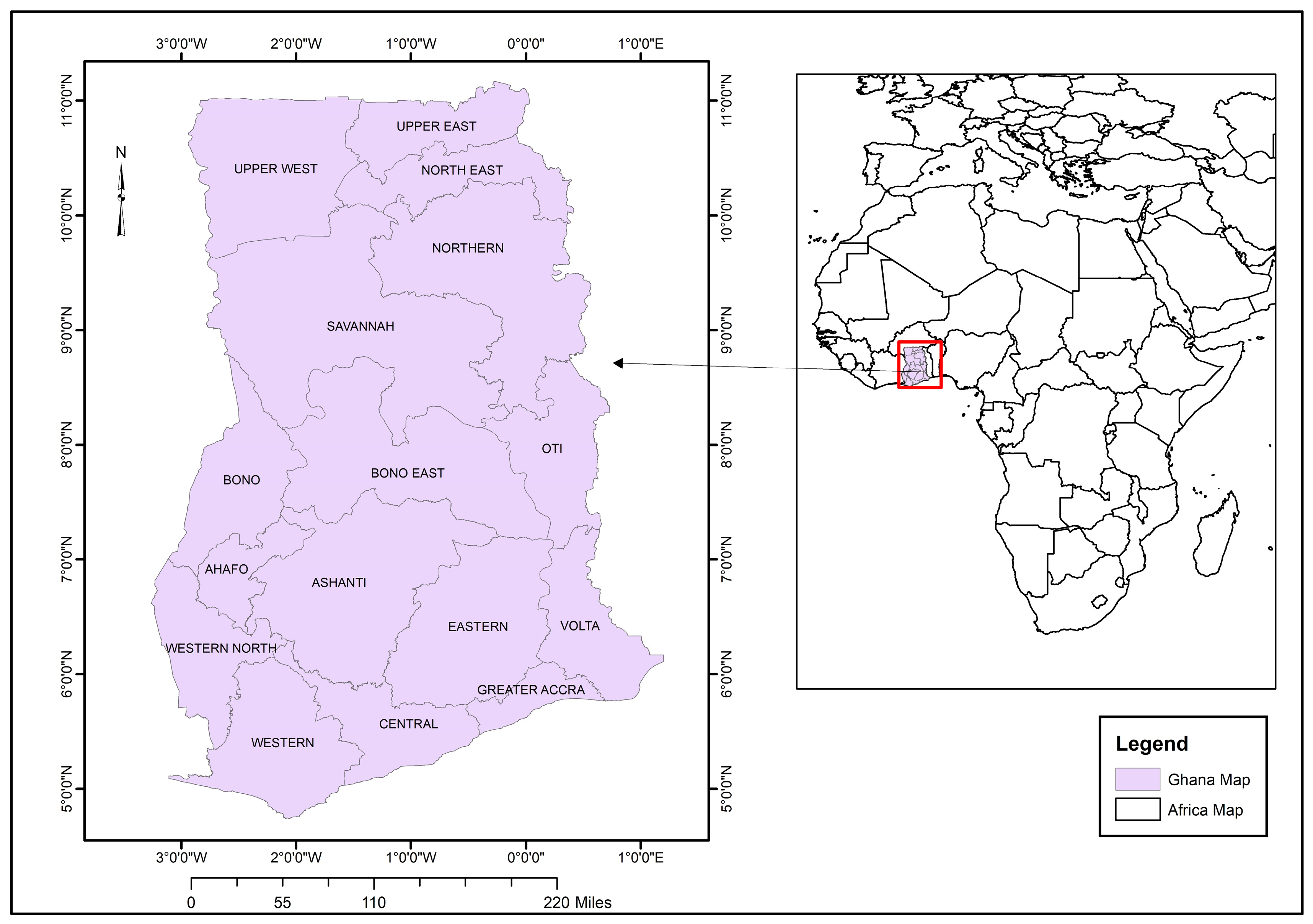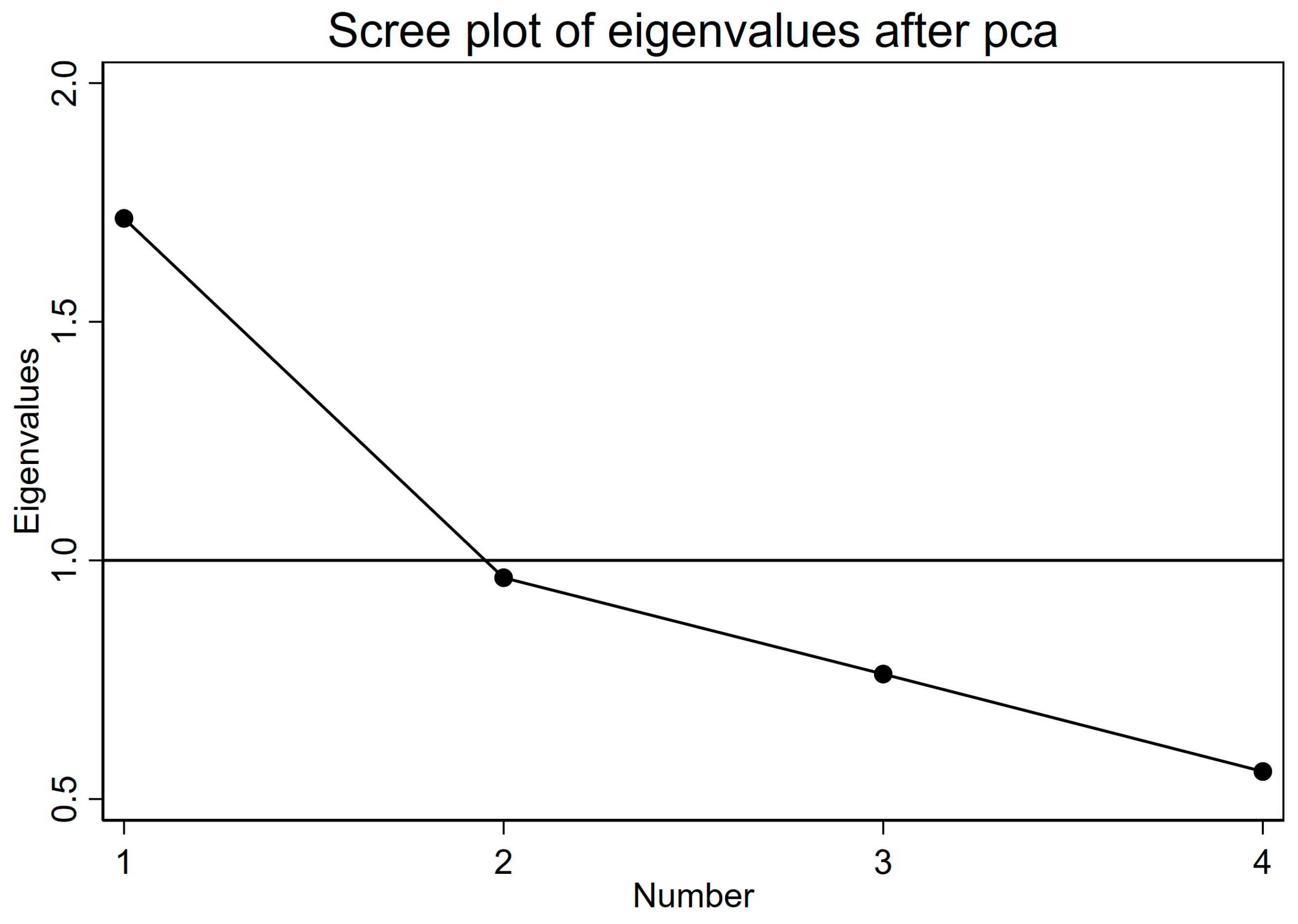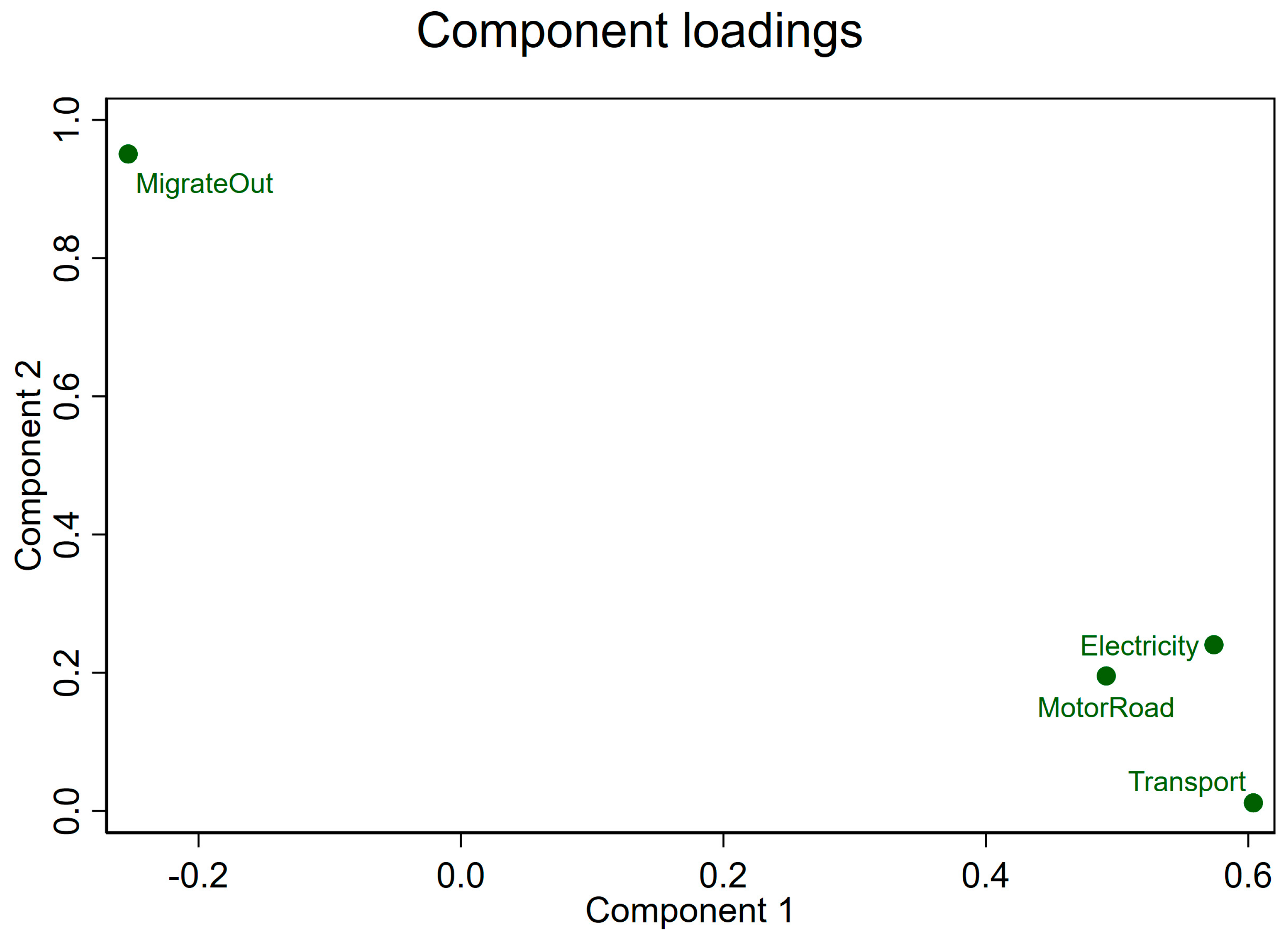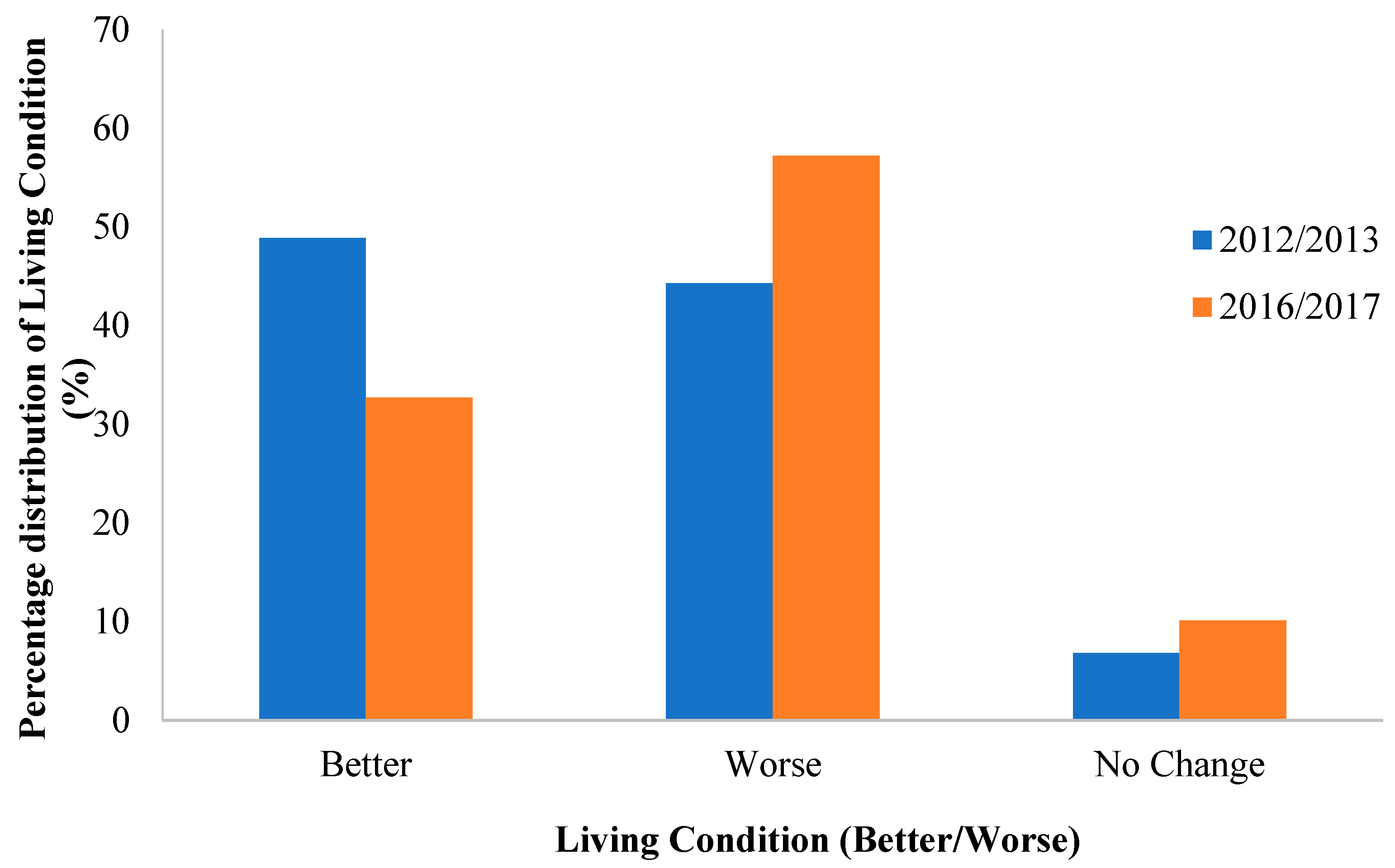Safeguarding Local Communities for REDD+ Implementation in Ghana
Abstract
1. Introduction
- What is the living condition of local communities in Ghana?
- What is the association between safeguard measures described in the Ghana Living Standard Survey (GLSS) and the living conditions of local communities in Ghana?
- Are the safeguard measures described in documents related to Ghana’s REDD+ program aligned with the determinants of the living conditions of local communities in Ghana?
2. Conceptual Framework
3. Materials and Methods
3.1. Study Area
3.2. Data Sources
- Ghana REDD+ strategy (GRS), 2016;
- Ghana Forest and Wildlife Policy (GFWP), 2012;
- Ghana Benefit Sharing Mechanism (GBSM), 2014;
- Ghana Forest Plantation Strategy (GFPS), 2016–2040.
3.3. Data Analysis
3.3.1. Model Estimation Strategy
3.3.2. Variables and Their Measurements
3.3.3. Principal Component Analysis
4. Results
4.1. Packages of Standard of Living: Principal Component Analysis (PCA)
4.2. Relationship between Safeguard Measures and Living Conditions of Local Communities
4.3. Alignment of Safeguard Measures in Ghana REDD+ Policy Documents with the Determinants of Local Communities’ Living Conditions
5. Discussion
5.1. Sharecropping
5.2. Literacy
5.3. Extension Access
5.4. Limitations of This Study
6. Conclusions
Author Contributions
Funding
Data Availability Statement
Acknowledgments
Conflicts of Interest
References
- Hirata, Y.; Takao, G.; Sato, T.; Toriyama, J. (Eds.) REDD-Plus Cookbook; REDD Research and Development Center, Forestry and Forest Products Research Institute Japan: Tsukuba, Japan, 2012; ISBN 978-4-905304-15-9. [Google Scholar]
- World Bank. In Ghana, Sustainable Cocoa-Forest Practices Yield Carbon Credits. Climate Stories: Ghana Carbon Credits. 2023. Available online: https://www.worldbank.org/en/news/feature/2023/06/01/in-ghana-sustainable-cocoa-forest-practices-yield-carbon-credits (accessed on 15 June 2023).
- FCPF. Ghana Cocoa Forest REDD+ Program; Verification Report Version 1.3, July 2022; Scientific Certification Systems Global Services (SCS): Emeryville, CA, USA, 2022. [Google Scholar]
- Derkyi, M.; Ros-Tonen, M.A.F.; Kyereh, B.; Dietz, T. Emerging Forest regimes and livelihoods in the Tano Offin Forest Reserve, Ghana: Implications for social safeguards. For. Policy Econ. 2013, 32, 49–56. [Google Scholar] [CrossRef]
- Poudyal, M.; Ramamonjisoa, B.S.; Hockley, N.; Rakotonarivo, O.S.; Gibbons, J.M.; Mandimbiniaina, R.; Jones, J.P. Can REDD+ social safeguards reach the ‘right’ people? Lessons from Madagascar. Glob. Environ. Chang. 2016, 37, 31–42. [Google Scholar] [CrossRef]
- Visseren-Hamakers, I.J.; McDermott, C.; Vijge, M.J.; Cashore, B. Trade-offs, co-benefits and safeguards: Current debates on the breadth of REDD+. Curr. Opin. Environ. Sustain. 2012, 4, 646–653. [Google Scholar] [CrossRef]
- Andoh, J.; Lee, Y. National REDD+ strategy for climate change mitigation: A review and comparison of developing Countries. Sustainability 2018, 10, 4781. [Google Scholar] [CrossRef]
- Andoh, J.; Oduro, K.A.; Park, J.; Lee, Y. Towards REDD+ implementation: Drivers of deforestation and forest degradation, REDD+ financing, and readiness activities in participant countries. Front. For. Glob. Chang. 2022, 5, e957550. [Google Scholar] [CrossRef]
- Forestry Commission of Ghana (FCG). Ghana National REDD+ Strategy. 2016. Available online: www.forestcarbonpartnership.org (accessed on 30 July 2018).
- Blay, D.; Appiah, M.; Damnyag, L.; Dwomoh, F.K.; Luukkanen, O.; Pappinen, A. Involving local farmers in rehabilitation of degraded tropical forests: Some lessons from Ghana. Environ. Dev. Sustain. 2008, 10, 503–518. [Google Scholar] [CrossRef]
- Andersson, K.P.; Smith, S.M.; Alston, L.J.; Duchelle, A.E.; Mwangi, E.; Larson, A.M.; de Sassi, C.; Sills, E.O.; Sunderlin, W.D.; Wong, G.Y. Wealth and the distribution of benefits from tropical forests: Implications for REDD+. Land Use Policy 2018, 72, 510–522. [Google Scholar] [CrossRef]
- Matson, P.; Clark, W.C.; Andersson, K. Pursuing Sustainability: A Guide to the Science and Practice; Princeton University Press: Princeton, NJ, USA, 2016. [Google Scholar]
- Torpey-Saboe, N.; Andersson, K.; Mwangi, E.; Persha, L.; Salk, C.; Wright, G. Benefit sharing among local resource users: The role of property rights. World Dev. 2015, 72, 408–418. [Google Scholar] [CrossRef]
- Arhin, A.A. Safeguards and dangerguards: A framework for unpacking the black box of safeguards for REDD+. For. Policy Econ. 2014, 45, 24–31. [Google Scholar] [CrossRef]
- Stickler, C.; Bezerra, T.; Nepstad, D. Global Rules for Sustainable Farming: A Comparison of Social and Environmental Safeguards for REDD+ and Principles & Criteria for Commodity Roundtables; The RT-REDD Consortium: Geneva, Switzerland, 2012; p. 14. [Google Scholar]
- Mackenzie, C. REDD+ Social Safeguards and Standards Review; Forest Carbon, Markets, and Communities Program (FCMC), Tetra Tech: Burlington, VT, USA, 2012; pp. 1–25. [Google Scholar]
- Roe, S.; Streck, C.; Pritchard, L.; Costenbader, J. Safeguards in REDD+ and Forest Carbon Standards: A Review of Social, Environmental, and Procedural Concepts and Application; Climate Focus: Amsterdam, The Netherlands, 2013. [Google Scholar]
- Merger, E.; Dutschke, M.; Verchot, L. Options for REDD+ voluntary certification to ensure net GHG benefits, poverty alleviation, sustainable management of forests, and biodiversity conservation. Forests 2011, 2, 550–577. [Google Scholar] [CrossRef]
- Moss, N.; Nussbaum, R.; Muchemi, J.; Halverson, E. A Review of Three REDD+ Safeguard Initiatives; UN-REDD and FCPF: Geneva, Switzerland, 2011. [Google Scholar]
- McDermott, C.L.; Coad, L.; Helfgott, A.; Schroeder, H. Operationalizing social safeguards in REDD+: Actors, interests, and ideas. Environ. Sci. Policy 2012, 21, 63–72. [Google Scholar] [CrossRef]
- Ros-Tonen, M.A.; Insaidoo, T.F.; Acheampong, E. Promising start, bleak outlook: The role of Ghana’s modified taungya system as a social safeguard in timber legality processes. For. Policy Econ. 2013, 32, 57–67. [Google Scholar] [CrossRef]
- Ghana Statistical Service. Available online: https://microdata.statsghana.gov.gh/ (accessed on 30 June 2024).
- Ghana Statistical Service. Ghana Living Standard Survey Round 7 Main Report; Ghana Statistical Service: Accra, Ghana, 2018. [Google Scholar]
- Novignon, J.; Nonvignon, J.; Mussa, R.; Chiwaula, L.S. Health and vulnerability to poverty in Ghana: Evidence from the Ghana Living Standards Survey Round 5. Health Econ. Rev. 2012, 2, 11. [Google Scholar] [CrossRef] [PubMed]
- Martey, E. Empirical analysis of crop diversification and energy poverty in Ghana. Energy Policy 2022, 165, 112952. [Google Scholar] [CrossRef]
- Sarkodie, A.O. Effect of the National Health Insurance Scheme on healthcare utilization and out-of-pocket payment: Evidence from GLSS 7. Humanit. Soc. Sci. Commun. 2021, 8, 293. [Google Scholar] [CrossRef]
- Forestry Commission of Ghana (FCG). Available online: https://fcghana.org (accessed on 5 February 2022).
- Dumenu, W.K.; Samar, S.; Mensah, J.K.; Derkyi, M.; Oduro, K.A.; Pentsil, S.; Obeng, E.A. Benefit Sharing Mechanism for REDD+ Implementation in Ghana; Consultancy Report; Forestry Commission: Accra, Ghana, 2014. [Google Scholar]
- Forestry Commission of Ghana (FCG). Ghana Forest Plantation Strategy; Forestry Commission of Ghana: Accra, Ghana, 2016. [Google Scholar]
- Mayring, P. Qualitative Content Analysis: Theoretical Foundation, Basic Procedures, and Software Solution; Open Access Repository: Klagenfurt, Austria, 2014; Available online: http://nbn-resolving.de/urn:nbn:de:0168-ssoar-395173 (accessed on 2 December 2021).
- Carodenuto, S.; Buluran, M. The effect of supply chain position on zero deforestation commitments: Evidence from the cocoa industry. J. Environ. Policy Plan. 2021, 23, 716–731. [Google Scholar] [CrossRef]
- Thomas, D.S.; Twyman, C.; Osbahr, H.; Hewitson, B. Adaptation to climate change and variability: Farmer responses to intra-seasonal precipitation trends in South Africa. In African Climate and Climate Change; Williams, C.J.R., Kniveton, D.R., Eds.; Springer: Dordrecht, The Netherlands, 2011; pp. 155–178. [Google Scholar]
- Filmer, D.; Pritchett, L.H. Estimating wealth effects without expenditure data—Or tears: An application to educational enrolments in states of India. Demography 2001, 38, 115–132. [Google Scholar] [PubMed]
- Merger, E.; Held, C.; Tennigkeit, T.; Blomley, T. A bottom-up approach to estimating cost elements of REDD+ pilot projects in Tanzania. Carbon Balance Manag. 2012, 7, 9. [Google Scholar] [CrossRef]
- Deveny, A.; Nackoney, J.; Purvis, N.; Gusti, M.; Kopp, R.J.; Madeira, E.M.; Stevenson, A.R.; Kindermann, G.; Macauley, M.K.; Obersteiner, M. Forest Carbon Index; Resources for the Future: Washington, DC, USA, 2009. [Google Scholar]
- Hansen, C.P.; Pouliot, M.; Marfo, E.; Obiri, B.D.; Treue, T. Forests, Timber and Rural Livelihoods: Implications for Social Safeguards in the Ghana-EU Voluntary Partnership Agreement. Small-Scale For. 2015, 15, 401–422. [Google Scholar] [CrossRef]
- Baah, K.; Kidido, J.K. Sharecropping arrangement in the contemporary agricultural economy of Ghana: A study of Techiman North District and Sefwi Wiawso Municipality, Ghana. J. Plan. Land Manag. 2020, 1, 50–62. [Google Scholar] [CrossRef]
- Quaye, W.; Ampadu, R.; Onuamah, J. Review of Existing Land Tenure Arrangements in Cocoa Growing Areas and Their Implications for the Cocoa Sector in Ghana; A Technical Report. 2014. Available online: https://www.academia.edu (accessed on 7 July 2022).
- Amanor, K.S.; Diderutuah, K.M. Share Contracts in the Oil Palm and Citrus Belt of Ghana; International Institute for Environment and Development: London, UK, 2001. [Google Scholar]
- Kasanga, R.; Kotey, N.A. Land Management in Ghana: Building on Tradition and Modernity; International Institute for Environment and Development: London, UK; Russel Press: Nottingham, UK, 2001; pp. 1–34. [Google Scholar]
- Hoffmann, C.; Márquez, J.R.G.; Krueger, T. A local perspective on drivers and measures to slow deforestation in the Andean-Amazonian foothills of Colombia. Land Use Policy 2018, 77, 379–391. [Google Scholar] [CrossRef]
- Darmawan, R.; Klasen, S.; Nuryartono, N. Migration and Deforestation in Indonesia (No. 19); Dokumenten-und Publikationsserver der Georg-August-Universität; GOEDOC: Göttingen, Germany, 2016. [Google Scholar]
- Agyeman, V.K.; Marfo, K.A.; Kasanga, K.R.; Danso, E.; Asare, A.B.; Yeboah, O.M.; Agyeman, F. Revising the taungya plantation system: New revenue-sharing proposals from Ghana. Unasylva 2003, 212, 40–43. [Google Scholar]
- Green, S.; Rich, T.; Nesman, E. Beyond individual literacy: The role of shared literacy for innovation in Guatemala. Hum. Organ. 1985, 44, 313–321. [Google Scholar] [CrossRef]
- Yeang, D.; Eam, S.; Sherchan, K.; Mckerrow, L. Local community participation in biodiversity monitoring and its implication for REDD+: A case study of Changkran Roy Community Forest in Cambodia. In Proceedings of the 7th International Conference on Environment and Rural Development, Phnom Penh, Cambodia, 16–17 January 2016. [Google Scholar]






| Variable List | Description | Mean | SD |
|---|---|---|---|
| AmntMan | Men average wage | 74.05 | 120.18 |
| AmntWoman | Woman average wage | 32.80 | 44.39 |
| CropOnce | Dummy for crop cultivated once | 0.66 | 0.47 |
| CropTwice | Dummy for crop cultivated twice | 0.24 | 0.42 |
| Tree Crop | Dummy for tree crop cultivated | 0.07 | 0.26 |
| OtherCrop | Dummy for other crops | 0.03 | 0.16 |
| PropShare | Proportion of sharecroppers | 0.18 | 0.26 |
| ExtenComm | Extension access | 0.19 | 0.39 |
| AdultLitComm | Adult literacy | 0.12 | 0.33 |
| Mobphone | Mobile phone network | 0.82 | 0.38 |
| FinanInst | Financial institution | 0.35 | 0.47 |
| DailyMkt | Daily market | 0.28 | 0.45 |
| Age | Age | 46.37 | 5.55 |
| HHsize | Household size | 4.55 | 1.41 |
| Sex | Sex | 0.69 | 0.17 |
| EduYear | Education years | 0.12 | 0.10 |
| PropTimePoor | Proportion of time poor | 0.34 | 0.23 |
| PropEconAct | Proportion of economic active | 0.79 | 0.19 |
| Coastal | Dummy for coastal zone | 0.23 | 0.39 |
| Forest | Dummy for forest zone | 0.40 | 0.48 |
| Savanna | Dummy for savanna zone | 0.37 | 0.48 |
| Variable | Comp1 1 | Comp2 1 | Unexplained | KMO 1 |
|---|---|---|---|---|
| Motorable road | 0.4918 | 0.1953 | 0.000 | 0.7097 |
| Electricity | 0.5738 | 0.2405 | 0.000 | 0.6055 |
| Migrate out | −0.2536 | 0.9507 | 0.000 | 0.6436 |
| Transport access | 0.6038 | 0.0116 | 0.000 | 0.5971 |
| Overall | 0.6237 |
| Variables | Regression Models | ||
|---|---|---|---|
| OLS | Poisson | Negative Binomial | |
| Men average wage | −0.001 *** | −0.001 | −0.001 |
| (0.001) | (0.001) | (0.001) | |
| Woman average wage | 0.001 *** | −0.001 *** | −0.001 *** |
| (0.000) | (0.001) | (0.001) | |
| Crop cultivated twice | 0.085 *** | 0.004 | 0.004 |
| (0.021) | (0.019) | (0.019) | |
| Tree crops | 0.132 *** | −0.131 *** | −0.131 *** |
| (0.027) | (0.029) | (0.029) | |
| Other crops | 0.052 | −0.161 *** | −0.161 *** |
| (0.043) | (0.034) | (0.034) | |
| Proportion of sharecroppers | 0.142 *** | −0.057 * | −0.057 * |
| (0.035) | (0.032) | (0.032) | |
| Extension access | 0.219 *** | 0.101 *** | 0.101 *** |
| (0.020) | (0.018) | (0.018) | |
| Adult literacy | 0.187 *** | 0.149 *** | 0.149 *** |
| (0.032) | (0.026) | (0.026) | |
| Mobile phone network | 0.525 *** | 0.571 *** | 0.571 *** |
| (0.031) | (0.031) | (0.031) | |
| Financial institution | 0.019 | 0.092 *** | 0.092 *** |
| (0.022) | (0.018) | (0.018) | |
| Daily market | 0.133 *** | 0.083 *** | 0.083 *** |
| (0.022) | (0.018) | (0.018) | |
| Age | 0.017 *** | 0.006 *** | 0.006 *** |
| (0.003) | (0.002) | (0.002) | |
| Household size | −0.048 *** | −0.052 *** | −0.052 *** |
| (0.010) | (0.010) | (0.010) | |
| Sex | −0.670 *** | −1.130 *** | −1.130 *** |
| (0.069) | (0.057) | (0.057) | |
| Elderly in community | −0.917 *** | −0.645 *** | −0.645 *** |
| (0.140) | (0.121) | (0.121) | |
| Education years | 0.079 *** | 0.040 *** | 0.040 *** |
| (0.004) | (0.004) | (0.004) | |
| Proportion of time poor | 0.118 ** | −0.022 | −0.022 |
| (0.046) | (0.037) | (0.037) | |
| Proportion of economic active | 0.052 | −0.029 | −0.029 |
| (0.062) | (0.051) | (0.051) | |
| Forest zone | −0.154 *** | −0.354 *** | −0.354 *** |
| (0.019) | (0.017) | (0.017) | |
| Savanna zone | −0.230 *** | −0.124 *** | −0.124 *** |
| (0.030) | (0.026) | (0.026) | |
| Constant | −0.998 *** | ||
| (0.155) | |||
| Lnalpha | −21.532 | ||
| (0.000) | |||
| Observations | 9203 | 9203 | 9203 |
| R−squared | 0.321 | ||
| Policy Document | Safeguard Measures Specified in the Policy Documents | Cancun Safeguards | Determinants of Living Conditions of Local Communities | |||||
|---|---|---|---|---|---|---|---|---|
| Sharecropping | Extension Access | Literacy | Mobile Phone Network | Financial Institution | Daily Community Market | |||
| GFWP |
| √ | ||||||
| √ | |||||||
| √ | |||||||
| A–G | |||||||
| ||||||||
| √ | |||||||
| √ | √ | √ | |||||
| GBSM |
| |||||||
| D–F | √ | ||||||
| ||||||||
| GFPS |
| √ | ||||||
| √ | |||||||
| A–G | √ | ||||||
| ||||||||
| √ | √ | ||||||
| GNRS |
| √ | ||||||
| A–G | |||||||
| ||||||||
Disclaimer/Publisher’s Note: The statements, opinions and data contained in all publications are solely those of the individual author(s) and contributor(s) and not of MDPI and/or the editor(s). MDPI and/or the editor(s) disclaim responsibility for any injury to people or property resulting from any ideas, methods, instructions or products referred to in the content. |
© 2024 by the authors. Licensee MDPI, Basel, Switzerland. This article is an open access article distributed under the terms and conditions of the Creative Commons Attribution (CC BY) license (https://creativecommons.org/licenses/by/4.0/).
Share and Cite
Andoh, J.; Martey, E.; Obeng, E.A.; Oduro, K.A.; Salimath, P.; Lee, Y. Safeguarding Local Communities for REDD+ Implementation in Ghana. Forests 2024, 15, 1349. https://doi.org/10.3390/f15081349
Andoh J, Martey E, Obeng EA, Oduro KA, Salimath P, Lee Y. Safeguarding Local Communities for REDD+ Implementation in Ghana. Forests. 2024; 15(8):1349. https://doi.org/10.3390/f15081349
Chicago/Turabian StyleAndoh, Jewel, Edward Martey, Elizabeth Asantewaa Obeng, Kwame Antwi Oduro, Pone Salimath, and Yohan Lee. 2024. "Safeguarding Local Communities for REDD+ Implementation in Ghana" Forests 15, no. 8: 1349. https://doi.org/10.3390/f15081349
APA StyleAndoh, J., Martey, E., Obeng, E. A., Oduro, K. A., Salimath, P., & Lee, Y. (2024). Safeguarding Local Communities for REDD+ Implementation in Ghana. Forests, 15(8), 1349. https://doi.org/10.3390/f15081349






